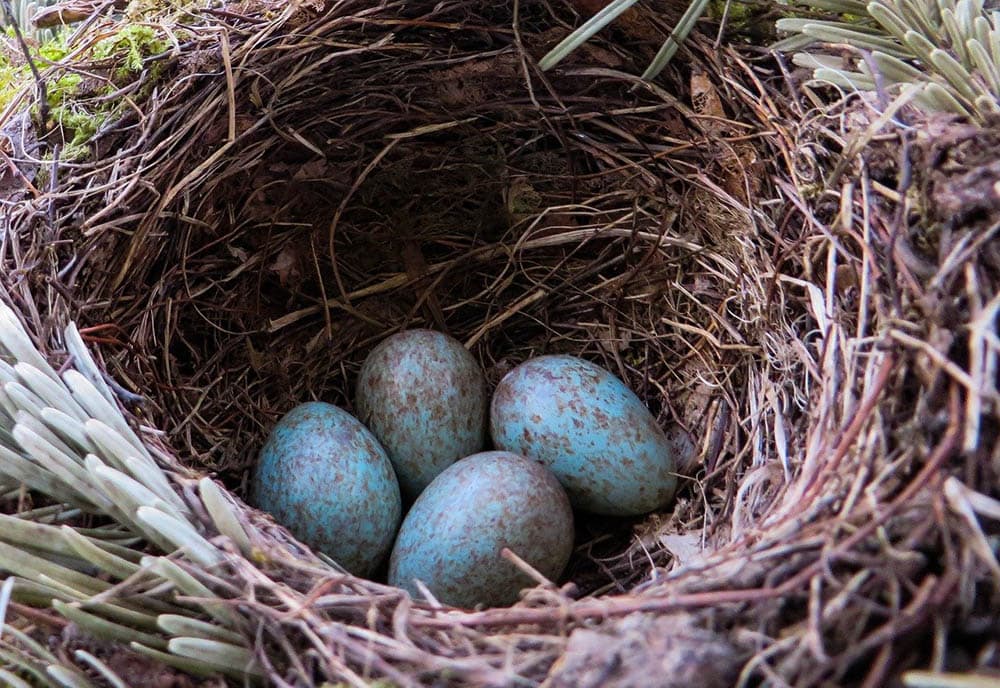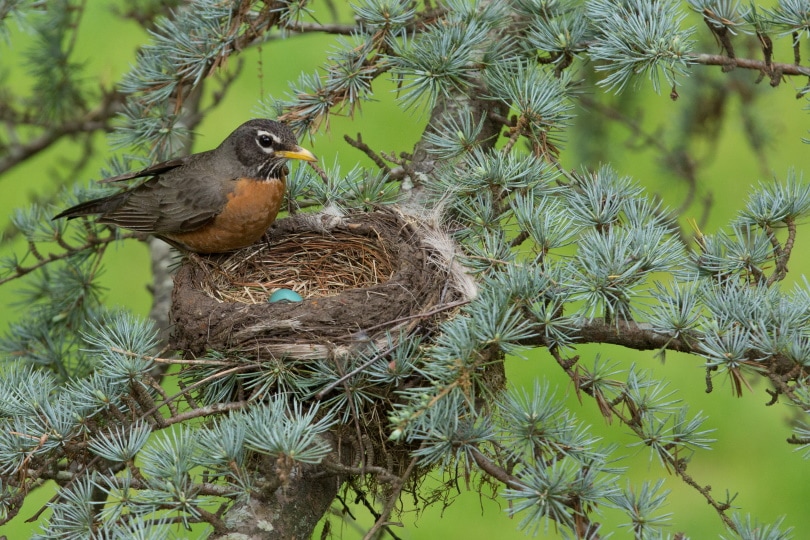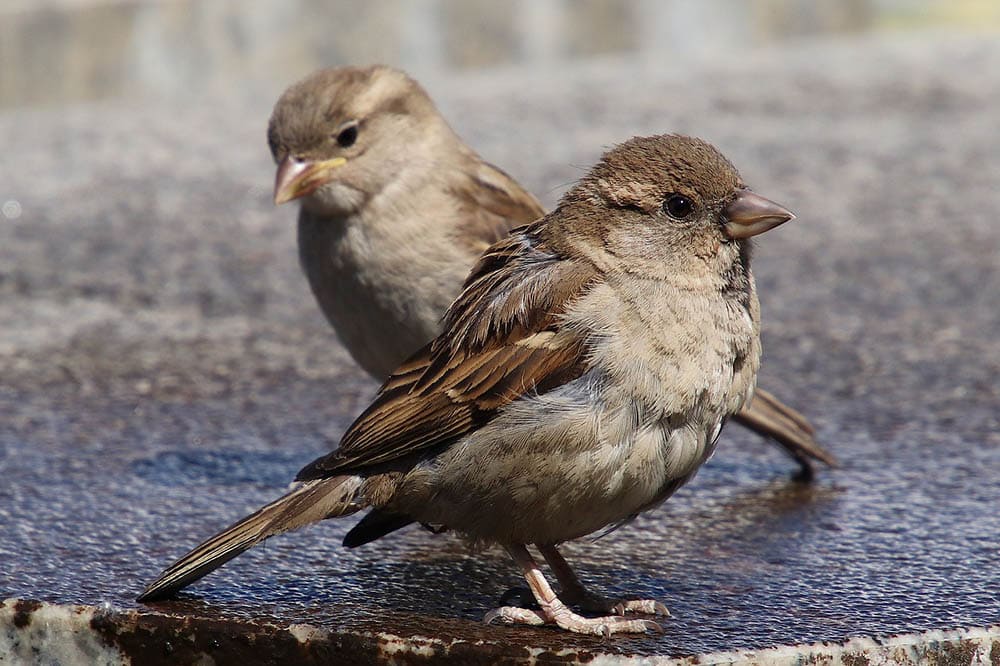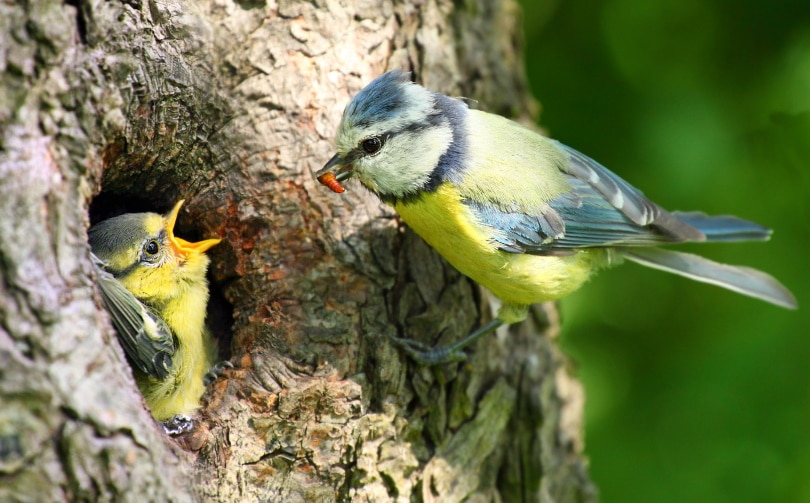When Do Birds Lay Eggs? What Science Tell Us
Last Updated on

Most people know that birds lay eggs, but there’s more to it than that. For one, not all birds lay eggs—a few birds produce live babies instead. Secondly, different bird species lay different types of eggs—from jade green to porcelain white, eggs can be fragile or tough, large or small. Finally, the time of year that a bird lays their eggs depends on the bird’s species. For example, some birds in the tropics lay their eggs all year long, while some birds in the Arctic only lay eggs during the summer.
Closer to home, some birds, like chickens, lay eggs every day. Other birds, like eagles, lay eggs once a year. The time of year and the frequency at which a bird lays its eggs can depend on several factors, like the temperature and the availability of food. Keep reading to look at some of the fascinating factors that go into the timing of egg-laying in birds.

When Are the Most Eggs Laid by Birds in a Year?
Most eggs are laid by birds during the spring and summer months. This is because these months are when birds are most active and have an abundance of food. The eggs are typically laid in nests, which birds build using materials such as grass, twigs, and leaves. However, the answer to this query is highly dependent on the species of bird in question.
Some birds, such as the American Robin, will lay a clutch of eggs every few days throughout the spring and early summer. Other birds, such as the Common Eider, will only lay a single egg each year, typically in late winter or early spring. So, it depends on the species of bird.

When Are the Fewest Eggs Laid by Birds in a Year?
The answer to this question is most likely during the winter months. Birds that migrate2, like geese or ducks, will typically stop laying eggs when they are on their migration route. This is because it takes a lot of energy to fly and also to keep warm, and the birds would rather save their energy for the journey. Other birds, like chickens, will also slow down their egg production in the winter.
What Is the Nesting Cycle?
The nesting cycle is defined as the time between when a bird starts building a nest and when the last egg in the nest cracks open. It is a reproductive pattern exhibited by a pair of birds, in which the female lays eggs and the parents incubate them until they hatch, after which the chicks are fed and sheltered by the parents until they are able to fend for themselves.
Which Birds Are Early Nesters?
Early nesters tend to be smaller songbirds. For example, the American Robin typically begins nesting in late February or early March, while the House Sparrow usually starts in late April or early May. These birds are able to take advantage of early spring conditions to build their nests and lay their eggs. By nesting early, they can avoid competition from other birds and ensure that their young have enough time to learn how to fly and find food before the summer arrives.

Which Birds Are Late Nesters?
Late nesters typically wait until the end of the nesting season to lay their eggs, which can be anywhere from late May to early July. Late nesters can include species such as Bluebirds, Swallows, and Warblers. One of the reasons these birds may delay nesting is to avoid competition from other birds for suitable nesting sites. Birds that are late nesters are typically those that require a higher level of parental care. They require more time to build their nests, incubate their eggs, and protect their young. This includes species like American Goldfinches and many Owls. Late nesting is often a strategy to take maximum advantage of the availability of food resources available in late summer.
Do Any Birds Lay Eggs in the Fall and Winter?
Year-round layers may produce eggs in the fall, but for most birds in temperate climates, the springtime is when conditions are more favorable for the development of their young. Some bird species may lay eggs a bit earlier or later in the year, or throughout the year, depending on the climate and other factors, but most birds avoid laying eggs during the colder, darker months of fall and winter.
Which Birds Lay Eggs Year Round?
The majority of birds lay eggs seasonally, with a smaller percentage laying eggs year-round. There are a few species of birds, however, that lay eggs year-round. These birds typically have a shorter incubation period, which allows them to lay eggs more frequently. The most common bird that lays eggs year-round is the House Sparrow. Other birds that lay eggs year-round include the American Goldfinch, the European Starling, and the Song Sparrow.
Birds that live in warm climates typically lay eggs year-round. They include birds such as Parrots, Macaws, and Cockatiels. They typically have a lower cyclical nesting instinct because laying eggs throughout the year in a constantly warm climate is not as risky as it is in a region that experiences a cold winter.

Which Wild Birds Lay Eggs Multiple Times in a Year?
The bird species that are capable of laying eggs multiple times in a year are typically those that reside in the tropics. This is because the conditions in the tropics—such as an abundance of food and warmer temperatures—allow these birds to produce more eggs than those living in colder climates. Some of these tropical bird species include the Green-Winged Macaw and Scarlet Ibis.
In North America too, there are a variety of wild birds that lay eggs multiple times a year. For example, many species of ducks will lay between 6 and 12 eggs per clutch, but will then lay another clutch a few weeks later. Some other birds that may lay multiple clutches of eggs in a year include Quail, Turkeys, and Pheasants.
Do Farmyard Birds Lay Eggs Year Round or Seasonally?
Free-range farmyard birds are capable of laying eggs year-round; however, their reproductive cycles are often synchronized with the changing of the seasons. The length of the day, temperature, and availability of food all play a role in controlling when a bird will lay eggs. In general, birds will lay more eggs when the weather is warm and there is an abundance of food available.

Why Do Some Chickens Lay Eggs in Winter?
Hens laying eggs during winter on commercial farms is a common occurrence. The hens are typically given supplemental light to stimulate egg production, as egg production naturally declines in the winter months. The eggs that are produced during this time are typically smaller and have a thinner shell than eggs produced at other times of the year. Chickens on commercial farms are typically kept in an environment where they can lay eggs all year round. This is done because eggs are a valuable source of revenue for the farm, and losing production due to cold weather would be economically damaging.
How Do Birds Know When to Lay an Egg?
The reproductive behavior of birds is regulated by an intricate interaction of hormones and external stimuli. The length of the day, changes in weather, and availability of food all play a role in when a bird will lay eggs. Birds have a reproductive cycle that is controlled by hormones. The hypothalamus in the brain monitors the levels of these hormones and sends signals to the pituitary gland. The pituitary gland then secretes follicle-stimulating hormone (FSH) and luteinizing hormone (LH). FSH stimulates the growth of follicles in the ovaries and LH causes the follicles to release an egg.

How Long Do Birds Lay Eggs After Mating?
The length of time that birds lay eggs after mating varies depending on the species of bird. In general, birds will lay eggs about two weeks after mating, but this can vary depending on the bird’s health, age, and other factors. Some birds, such as the American Robin, will start laying eggs within a few days of mating, while others, like the Bald Eagle, may wait several weeks. The Atlantic Puffin may not lay eggs for up to 6 months after mating!
What Are the Signs That a Bird is Laying an Egg?
The physical signs that a bird is laying an egg can vary depending on the species of bird. In general, however, the female will become more secretive and will spend more time in her nest. Additionally, the bird’s behavior may change and they may become more aggressive or territorial.
What Time of Day Do Birds Lay Their Eggs?
In a study of about 40 species of Central American birds, scientists found that the hatching times were consistent for 14 species. Within a locality, each of those bird species lays their eggs at a different time of day. For example, Tanagers, Finches, Wood Warblers, Honeycreepers, Wrens, and Hummingbirds typically lay their eggs just before dawn or soon after, whereas the American Flycatcher typically lays later in the morning, often much closer to noon.
Although this was a small, localized study, we can extrapolate that further research would likely find that many other species of bird may lay their eggs at specific times of the day.

Does the Age of a Bird Affect When it Lays Eggs?
In general, younger birds lay eggs later in the breeding season than older birds. One reason for this is that younger birds have not yet reached their maximum size and body condition, and so they require more time to accumulate the resources they need to produce eggs. Additionally, many younger birds have not yet learned all of the skills they need to be successful breeders. They may not know how to find good nesting sites or how to protect their nests from predators.
A study of Snow Petrels in Antarctica concluded that age-related factors such as breeding experience and foraging skills had a deep impact on the timing of when this species laid their eggs. On the other hand, there was no observable effect of age on laying dates in Yellow-Eyed Penguins, so this trend does not hold for all bird species.
Are Seasonal Nesting Patterns Changing?
There is evidence that seasonal nesting patterns are changing, but it is still unclear how this is impacting bird populations. Some scientists believe that changing climate conditions are causing birds to nest earlier in the year, but others think that changes in human land use are the primary driver of these shifts. Whatever the cause, it is clear that many birds are nesting at different times than they have in the past, and this could have serious implications for their long-term survival.
Final Thoughts
There are many different types of birds and each species lays eggs at a different time. Some birds even lay eggs more than once a year! Some birds lay eggs during the springtime, while others lay eggs during the summer or even year-round. The majority of bird species lay eggs when the weather is warming up and the days are getting longer.
If you want to see baby birds, be sure to keep an eye out for nests in your neighborhood. It is important to be aware of when different bird species lay their eggs so that you can properly observe and appreciate these beautiful creatures.
See Also: Why Do Some Birds Lay Their Eggs in Other Bird’s Nests? The Interesting Answer!
Featured Image Credit: foto-augenblick, Pixabay
Table of Contents
- When Are the Most Eggs Laid by Birds in a Year?
- When Are the Fewest Eggs Laid by Birds in a Year?
- What Is the Nesting Cycle?
- Which Birds Are Early Nesters?
- Which Birds Are Late Nesters?
- Do Any Birds Lay Eggs in the Fall and Winter?
- Which Birds Lay Eggs Year Round?
- Which Wild Birds Lay Eggs Multiple Times in a Year?
- Do Farmyard Birds Lay Eggs Year Round or Seasonally?
- Why Do Some Chickens Lay Eggs in Winter?
- How Do Birds Know When to Lay an Egg?
- How Long Do Birds Lay Eggs After Mating?
- What Are the Signs That a Bird is Laying an Egg?
- What Time of Day Do Birds Lay Their Eggs?
- Does the Age of a Bird Affect When it Lays Eggs?
- Are Seasonal Nesting Patterns Changing?
- Final Thoughts
About the Author Robert Sparks
Robert’s obsession with all things optical started early in life, when his optician father would bring home prototypes for Robert to play with. Nowadays, Robert is dedicated to helping others find the right optics for their needs. His hobbies include astronomy, astrophysics, and model building. Originally from Newark, NJ, he resides in Santa Fe, New Mexico, where the nighttime skies are filled with glittering stars.
Related Articles:
10 Types of Hummingbirds in Arkansas (With Pictures)
8 Types of Hummingbirds in Nebraska (With Pictures)
5 Types of Hummingbirds in Idaho (With Pictures)
3 Types of Hummingbirds in Mississippi (With Pictures)
8 Types of Hummingbirds in Kansas (With Pictures)
5 Types of Hummingbirds in West Virginia (With Pictures)
5 Types of Hummingbirds in Ohio (With Pictures)
Where Do Nuthatches Nest? Nuthatch Nesting Habits Explained
